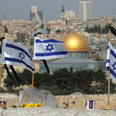
Under the headline "The Ultra-Holy City" the magazine describes the "sophisticated" haredi conquest of Jewish neighborhoods, as part of a battle for the identity of the Jewish State.
The magazine interviewed haredi Elhanan Gibli who moved to the neighborhood of Kiryat Yovel three years ago and secular Noam Pinchasi, a veteran of the neighborhood.
The backdrop for the battle of Kiryat Yovel is the recent exodus of secular residents from Jerusalem.
According to Time, some 20,000 have left Jerusalem the past seven years alone, reducing the share of the population "who wear their faith lightly" from a 37% plurality to a 31% minority, the same percentage as the ultra-Orthodox, but the number of ultra-Orthodox is rising.

Time magazine cover
The article treated the city as a case study for the identity of the State of Israel: "It's a flight much of Israel is watching with concern bordering on alarm."
The article describes the recent debate over the drafting of haredi yeshiva students to the IDF and claims: "The ultra-Orthodox, whose hermetic lifestyle may be based on preoccupation with the next world but whose political clout defines savvy in this one, also enjoy subsidies for child care, education and housing.
"The community's power only grows with its numbers. Uncontained, it stands to fundamentally alter Israel's identity."
The magazine goes on to add: Three generations ago, the ultra-Orthodox were all but extinct. Their Lazarus-like comeback either threatens the fabric of Israel.
"This means not only side locks on men and wigs or scarves on women but also separating girls from boys as early as nursery school. It means barring smart phones, which can access licentiousness on the Internet. It means a host of things far more easily assured if everyone in town is pulling in the same direction."
When Gibli moved to his current home three years ago, he was the first haredi in the building. Now haredim own four out of the eight apartments in the building.
In an interview to Time, Pinchasi said "This is a war over territory," while stressing that he is not willing to give up on Kiryat Yovel's secular identity.
Pinchasi leads commando raids which involve slapping posters of classic nude paintings on synagogue doors in the neighborhood in a bid to deter the haredim.
"They're afraid their children will see things they shouldn't see," he explains.
"Our message is very strong and clear: This is not like Ramot, Ramot Eshkol, Neve Yaakov, Maalot Dafna," he says, naming Jerusalem neighborhoods that started out secular and are now haredi.
"Here it is going to be war."
The magazine notes that Pinchasi's "crusade" began after a pair of neighborhood pools banned mixed swimming during daylight hours and when unlicensed synagogues appeared in homes and storefronts.
Time describes Pinchasi's story as that of a man winning small battles but losing the war.
Religious Jews may account for less than 20% of the neighborhood's 21,000 residents, but they keep arriving.
"Ten, 15 years from now, it's all going to be ultra-Orthodox," said one religious resident.















